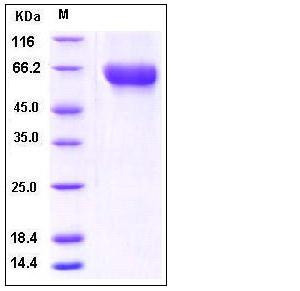Human CNDP1 Protein (His Tag)
CN1,CPGL2,HsT2308
- 100ug (NPP3747) Please inquiry
| Catalog Number | P10077-H08H |
|---|---|
| Organism Species | Human |
| Host | Human Cells |
| Synonyms | CN1,CPGL2,HsT2308 |
| Molecular Weight | The recombinant human CNDP1 consists of 492 amino acids and has a calculated molecular mass of 55.3 kDa. As a result of glycosylation, the protein migrates as an approximately 60-65 kDa band in SDS-PAGE under reducing conditions. |
| predicted N | Ser 27 |
| SDS-PAGE |  |
| Purity | > 90 % as determined by SDS-PAGE and SEC-HPLC Analysis. |
| Protein Construction | A DNA sequence encoding the mature form of human CNDP1 (NP_116038.4) (Ser27-His507) was fused with a polyhistidine tag at the C-terminus. |
| Bio-activity | Measured by its ability to cleave carnosine (βAlaLHis) in a twostep assay. The specific activity is > 250 pmoles/min/μg. |
| Research Area | Cancer |Invasion microenvironment |Adhesion molecule |Extracelluar matrix |Extracellualr matrix proteases & regulators |Matrix metalloproteinase (MMP) | |
| Formulation | Lyophilized from sterile PBS, pH 7.4 1. Normally 5 % - 8 % trehalose and mannitol are added as protectants before lyophilization. Specific concentrations are included in the hardcopy of COA. |
| Background | CNDP1, also known as carnosine dipeptidase 1, glutamate carboxypeptidase-like protein 2 (CPGL-2) or carnosinase 1 (CN1), is a member of the M20 metalloprotease family. The CNDP1 gene contains trinucleotide (CTG) repeat length polymorphism in the coding region, which has been demonstrated to be associated with susceptibility to developing diabetic nephropathy, for carnosine protection against the adverse effects of high glucose levels on renal cells. In humans, CNDP1 is secreted from the liver into the serum. In other mammals, including rodents, CNDP1 is expressed exclusively within the kidney and lacks a signal peptide. CNDP1 protein is a secreted homodimeric dipeptidase that specifically hydrolyzes L-carnosine (β-alanyl-L-histidine), and is identified as human carnosinase expressed in the brain. CNDP1 has been associated with diabetic nephropathy in Europeans and European Americans, but not African-Americans. It was identified and confirmed as a risk factor, were cross-sectional and mostly in patients with type 2 diabetes. The polymorphisms of CNDP1 can be excluded as a risk factor for nephropathy in type 1 diabetes. In addition, CNDP1 is also suggested to be implicated in the actions of neuroprotection and neurotransmiting. |
| Reference |
